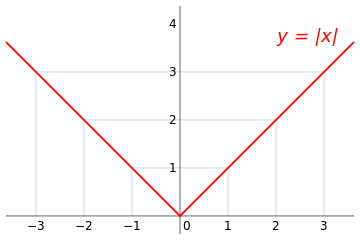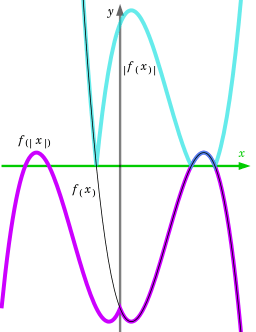Absolute value

In mathematics, the absolute value or modulus |x| of a real number x is the non-negative value of x without regard to its sign. Namely, |x| = x for a positive x, |x| = −x for a negative x (in which case −x is positive), and |0| = 0. For example, the absolute value of 3 is 3, and the absolute value of −3 is also 3. The absolute value of a number may be thought of as its distance from zero.
Generalisations of the absolute value for real numbers occur in a wide variety of mathematical settings. For example, an absolute value is also defined for the complex numbers, the quaternions, ordered rings, fields and vector spaces. The absolute value is closely related to the notions of magnitude, distance, and norm in various mathematical and physical contexts.
Terminology and notation
In 1806, Jean-Robert Argand introduced the term module, meaning unit of measure in French, specifically for the complex absolute value,[1][2] and it was borrowed into English in 1866 as the Latin equivalent modulus.[1] The term absolute value has been used in this sense from at least 1806 in French[3] and 1857 in English.[4] The notation |x|, with a vertical bar on each side, was introduced by Karl Weierstrass in 1841.[5] Other names for absolute value include numerical value[1] and magnitude.[1]
The same notation is used when x is a set to denote cardinality; the meaning depends on context.
Definition and properties
Real numbers
For any real number x the absolute value or modulus of x is denoted by |x| (a vertical bar on each side of the quantity) and is defined as[6]
As can be seen from the above definition, the absolute value of x is always either positive or zero, but never negative.
From an analytic geometry point of view, the absolute value of a real number is that number's distance from zero along the real number line, and more generally the absolute value of the difference of two real numbers is the distance between them. Indeed, the notion of an abstract distance function in mathematics can be seen to be a generalisation of the absolute value of the difference (see "Distance" below).
Since the square root notation without sign represents the positive square root, it follows that
(1)
which is sometimes used as a definition of absolute value of real numbers.[7]
The absolute value has the following four fundamental properties:
(2) Non-negativity (3) Positive-definiteness (4) Multiplicativeness (5) Subadditivity
Other important properties of the absolute value include:
(6) Idempotence (the absolute value of the absolute value is the absolute value) (7) Evenness (reflection symmetry of the graph) (8) Identity of indiscernibles (equivalent to positive-definiteness) (9) Triangle inequality (equivalent to subadditivity) (if ) (10) Preservation of division (equivalent to multiplicativeness) (11) Reverse triangle inequality (equivalent to subadditivity)
Two other useful properties concerning inequalities are:
- or
These relations may be used to solve inequalities involving absolute values. For example:
Absolute value is used to define the absolute difference, the standard metric on the real numbers.
Complex numbers

Since the complex numbers are not ordered, the definition given above for the real absolute value cannot be directly generalised for a complex number. However the geometric interpretation of the absolute value of a real number as its distance from 0 can be generalised. The absolute value of a complex number is defined as its distance in the complex plane from the origin using the Pythagorean theorem. More generally the absolute value of the difference of two complex numbers is equal to the distance between those two complex numbers.
For any complex number
where x and y are real numbers, the absolute value or modulus of z is denoted |z| and is given by[8]
When the imaginary part y is zero this is the same as the absolute value of the real number x.
When a complex number z is expressed in polar form as
with r ≥ 0 and θ real, its absolute value is
- .
The absolute value of a complex number can be written in the complex analogue of equation (1) above as:
where z is the complex conjugate of z. Notice that, contrary to equation (1):
- .
The complex absolute value shares all the properties of the real absolute value given in equations (2)–(11) above.
Since the positive reals form a subgroup of the complex numbers under multiplication, we may think of absolute value as an endomorphism of the multiplicative group of the complex numbers.[9]
Absolute value function


The real absolute value function is continuous everywhere. It is differentiable everywhere except for x = 0. It is monotonically decreasing on the interval (−∞,0] and monotonically increasing on the interval [0,+∞). Since a real number and its opposite have the same absolute value, it is an even function, and is hence not invertible. The real absolute value function is a piecewise linear, convex function.
Both the real and complex functions are idempotent.
Relationship to the sign function
The absolute value function of a real number returns its value irrespective of its sign, whereas the sign (or signum) function returns a number's sign irrespective of its value. The following equations show the relationship between these two functions:
or
and for x ≠ 0,
Derivative
The real absolute value function has a derivative for every x ≠ 0, but is not differentiable at x = 0. Its derivative for x ≠ 0 is given by the step function[10][11]
The subdifferential of |x| at x = 0 is the interval [−1,1].[12]
The complex absolute value function is continuous everywhere but complex differentiable nowhere because it violates the Cauchy–Riemann equations.[10]
The second derivative of |x| with respect to x is zero everywhere except zero, where it does not exist. As a generalised function, the second derivative may be taken as two times the Dirac delta function.
Antiderivative
The antiderivative (indefinite integral) of the absolute value function is
where C is an arbitrary constant of integration.
Distance
The absolute value is closely related to the idea of distance. As noted above, the absolute value of a real or complex number is the distance from that number to the origin, along the real number line, for real numbers, or in the complex plane, for complex numbers, and more generally, the absolute value of the difference of two real or complex numbers is the distance between them.
The standard Euclidean distance between two points
and
in Euclidean n-space is defined as:
This can be seen to be a generalisation of |a − b|, since if a and b are real, then by equation (1),
While if
and
are complex numbers, then
The above shows that the "absolute value" distance for the real numbers or the complex numbers, agrees with the standard Euclidean distance they inherit as a result of considering them as the one and two-dimensional Euclidean spaces respectively.
The properties of the absolute value of the difference of two real or complex numbers: non-negativity, identity of indiscernibles, symmetry and the triangle inequality given above, can be seen to motivate the more general notion of a distance function as follows:
A real valued function d on a set X × X is called a metric (or a distance function) on X, if it satisfies the following four axioms:[13]
Non-negativity Identity of indiscernibles Symmetry Triangle inequality
Generalizations
Ordered rings
The definition of absolute value given for real numbers above can be extended to any ordered ring. That is, if a is an element of an ordered ring R, then the absolute value of a, denoted by |a|, is defined to be:[14]
where −a is the additive inverse of a, and 0 is the additive identity element.
Fields
The fundamental properties of the absolute value for real numbers given in (2)–(5) above, can be used to generalise the notion of absolute value to an arbitrary field, as follows.
A real-valued function v on a field F is called an absolute value (also a modulus, magnitude, value, or valuation)[15] if it satisfies the following four axioms:
Non-negativity Positive-definiteness Multiplicativeness Subadditivity or the triangle inequality
Where 0 denotes the additive identity element of F. It follows from positive-definiteness and multiplicativeness that v(1) = 1, where 1 denotes the multiplicative identity element of F. The real and complex absolute values defined above are examples of absolute values for an arbitrary field.
If v is an absolute value on F, then the function d on F × F, defined by d(a, b) = v(a − b), is a metric and the following are equivalent:
- d satisfies the ultrametric inequality for all x, y, z in F.
- is bounded in R.
- for every
- for all
- for all
An absolute value which satisfies any (hence all) of the above conditions is said to be non-Archimedean, otherwise it is said to be Archimedean.[16]
Vector spaces
Again the fundamental properties of the absolute value for real numbers can be used, with a slight modification, to generalise the notion to an arbitrary vector space.
A real-valued function on a vector space V over a field F, represented as ‖·‖, is called an absolute value, but more usually a norm, if it satisfies the following axioms:
For all a in F, and v, u in V,
Non-negativity Positive-definiteness Positive homogeneity or positive scalability Subadditivity or the triangle inequality
The norm of a vector is also called its length or magnitude.
In the case of Euclidean space Rn, the function defined by
is a norm called the Euclidean norm. When the real numbers R are considered as the one-dimensional vector space R1, the absolute value is a norm, and is the p-norm (see Lp space) for any p. In fact the absolute value is the "only" norm on R1, in the sense that, for every norm ‖·‖ on R1, ‖x‖ = ‖1‖ ⋅ |x|. The complex absolute value is a special case of the norm in an inner product space. It is identical to the Euclidean norm, if the complex plane is identified with the Euclidean plane R2.
Composition algebras
Every composition algebra A has an involution x → x* called its conjugation. The product in A of an element x and its conjugate x* is written N(x) = x x* and called the norm of x.
The real numbers ℝ, complex numbers ℂ, and quaternions ℍ are all composition algebras with norms given by definite quadratic forms. The absolute value in these division algebras is given by the square root of the composition algebra norm.
In general the norm of a composition algebra may be a quadratic form that is not definite and has null vectors. However, as in the case of division algebras, when an element x has a non-zero norm, then x has a multiplicative inverse given by x*/N(x).
Notes
- 1 2 3 4 Oxford English Dictionary, Draft Revision, June 2008
- ↑ Nahin, O'Connor and Robertson, and functions.Wolfram.com.; for the French sense, see Littré, 1877
- ↑ Lazare Nicolas M. Carnot, Mémoire sur la relation qui existe entre les distances respectives de cinq point quelconques pris dans l'espace, p. 105 at Google Books
- ↑ James Mill Peirce, A Text-book of Analytic Geometry at Google Books. The oldest citation in the 2nd edition of the Oxford English Dictionary is from 1907. The term absolute value is also used in contrast to relative value.
- ↑ Nicholas J. Higham, Handbook of writing for the mathematical sciences, SIAM. ISBN 0-89871-420-6, p. 25
- ↑ Mendelson, p. 2.
- ↑ Stewart, James B. (2001). Calculus: concepts and contexts. Australia: Brooks/Cole. ISBN 0-534-37718-1., p. A5
- ↑ González, Mario O. (1992). Classical Complex Analysis. CRC Press. p. 19. ISBN 9780824784157.
- ↑ Lorenz, Falko (2008), Algebra. Vol. II. Fields with structure, algebras and advanced topics, Universitext, New York: Springer, p. 39, doi:10.1007/978-0-387-72488-1, ISBN 978-0-387-72487-4, MR 2371763.
- 1 2 Weisstein, Eric W. Absolute Value. From MathWorld – A Wolfram Web Resource.
- ↑ Bartel and Sherbert, p. 163
- ↑ Peter Wriggers, Panagiotis Panatiotopoulos, eds., New Developments in Contact Problems, 1999, ISBN 3-211-83154-1, p. 31–32
- ↑ These axioms are not minimal; for instance, non-negativity can be derived from the other three: 0 = d(a, a) ≤ d(a, b) + d(b, a) = 2d(a, b).
- ↑ Mac Lane, p. 264.
- ↑ Shechter, p. 260. This meaning of valuation is rare. Usually, a valuation is the logarithm of the inverse of an absolute value
- ↑ Shechter, pp. 260–261.
References
- Bartle; Sherbert; Introduction to real analysis (4th ed.), John Wiley & Sons, 2011 ISBN 978-0-471-43331-6.
- Nahin, Paul J.; An Imaginary Tale; Princeton University Press; (hardcover, 1998). ISBN 0-691-02795-1.
- Mac Lane, Saunders, Garrett Birkhoff, Algebra, American Mathematical Soc., 1999. ISBN 978-0-8218-1646-2.
- Mendelson, Elliott, Schaum's Outline of Beginning Calculus, McGraw-Hill Professional, 2008. ISBN 978-0-07-148754-2.
- O'Connor, J.J. and Robertson, E.F.; "Jean Robert Argand".
- Schechter, Eric; Handbook of Analysis and Its Foundations, pp. 259–263, "Absolute Values", Academic Press (1997) ISBN 0-12-622760-8.
External links
- Hazewinkel, Michiel, ed. (2001), "Absolute value", Encyclopedia of Mathematics, Springer, ISBN 978-1-55608-010-4
- absolute value at PlanetMath.org.
- Weisstein, Eric W. "Absolute Value". MathWorld.